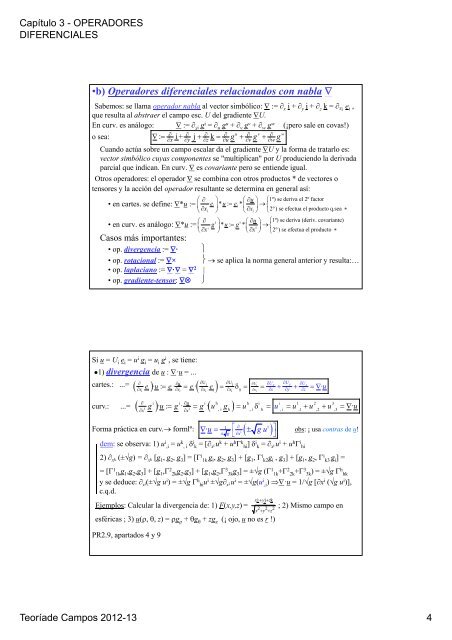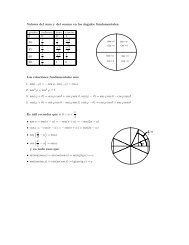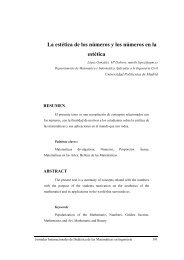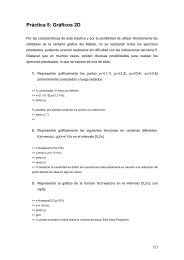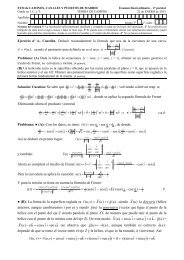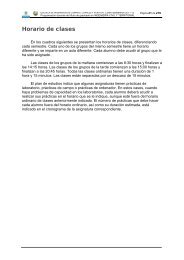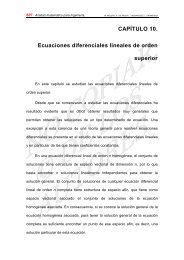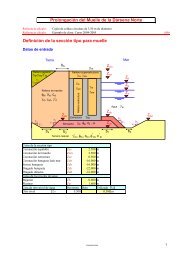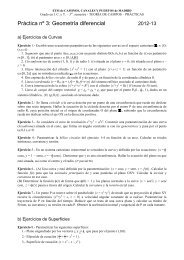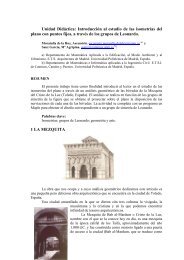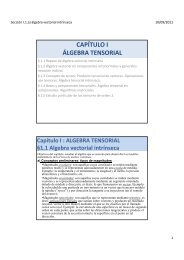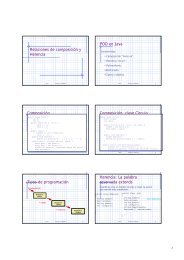Capítulo 3 - OPERADORES DIFERENCIALES Teoríade Campos ...
Capítulo 3 - OPERADORES DIFERENCIALES Teoríade Campos ...
Capítulo 3 - OPERADORES DIFERENCIALES Teoríade Campos ...
- No tags were found...
Create successful ePaper yourself
Turn your PDF publications into a flip-book with our unique Google optimized e-Paper software.
<strong>Capítulo</strong> 3 - <strong>OPERADORES</strong><strong>DIFERENCIALES</strong>•b) Operadores diferenciales relacionados con nabla Sabemos: se llama operador nabla al vector simbólico: := x i+ y j+ z k= x i e i ,que resulta al abstraer el campo esc. U del gradiente U.En curv. es análogo: := x i g i = u g u + v g v + w g w (¡pero sale en covas!)u v wo sea: :i+jkx y z ugvg wgCuando actúa sobre un campo escalar da el gradiente U y la forma de tratarlo es:vector simbólico cuyas componentes se "multiplican" por U produciendo la derivadaparcial que indican. En curv. es covariante pero se entiende igual.Otros operadores: el operador se combina con otros productos * de vectores otensores y la acción del operador resultante se determina en general así: u 1º) se deriva el 2º factor• en cartes. se define: *u := ei* u: ei* xi xi 2º ) se efectua el producto q.sea i i u 1º) se deriva (deriv. covariante)• en curv. es análogo: *u := gi* u: g * i x x 2º ) se efectua el producto Casos más importantes:• op. divergencia := · • op. rotacional := × se aplica la norma general anterior y resulta:…• op. laplaciano := · = 2 |• op. gradiente-tensor: Si u = U i e i = u i g i = u i g i , se tiene:●1) divergencia de u : ·u = ...cartes.: ...=curv.: ...=Forma práctica en curv. formlº:1 i· u i gu obs: ¡ usa contras de u! g xdem: se observa: 1) u i ,i = u k , i i k = [ x i u k + u h k hi] i k = x i u i + u h i hi2) ∂ x k (±√g) = ∂ x k [g 1 , g 2 , g 3 ] = [ i 1k g i , g 2 , g 3 ] + [g 1 , i k2g i , g 3 ] + [g 1 , g 2 , i k3 g i ] == [ 1 1kg 1 ,g 2 ,g 3 ] + [g 1 , 2 2kg 2 ,g 3 ] + [g 1 ,g 2 , 3 3kg 3 ] = ±√g ( 1 1k+ 2 2k+ 3 3k) = ±√g h hky se deduce: x i(±√gu i ) = ±√g h hiu i ±√g x i u i = ±√g(u i ,i) ·u = 1/√g [x i (√gu i )],c.q.d.Ejemplos: Calcular la divergencia de: 1) F(x,y,z) =esféricas ; 3) u(, , z) = g + g + zg z (¡ ojo, u no es r !)PR2.9, apartados 4 y 9uUjUjU ix ·i i x i xj xij xx y ze · u : e· e e ·ui i i iu i i xiUUUx y zg · u : g · g · u g u u u u u ·ui i i h h i i 1 2 3x, i h , i h , i ,1 ,2 ,3xiyjzkx2y 2z2; 2) Mismo campo en<strong>Teoríade</strong> <strong>Campos</strong> 2012-13 4


